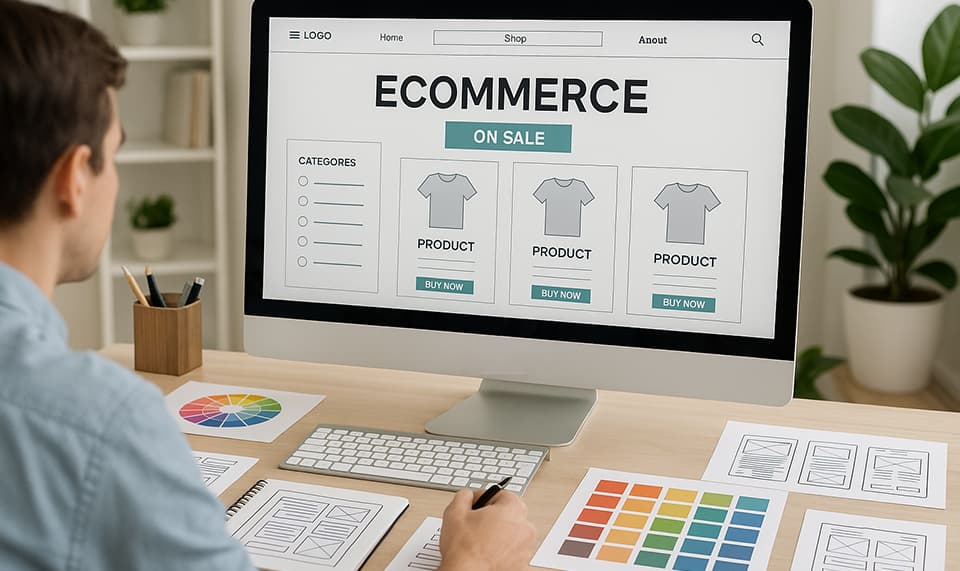The Role of UX/UI in eCommerce Website

Digital shopping drives success for internet stores when its User Experience (UX) and User Interface (UI) features help users browse and shop their favorite sites. An excellent online store design consists of two core components that determine how users interact with the platform, which directly affects their purchase behavior and level of engagement. A properly built UX/UI framework supports better customer conversions and builds brand credibility, but users will leave when faced with bad design.
This article studies how UX/UI elements enhance eCommerce development through better sales results and keeps users returning while making the platform engaging for them. The article demonstrates proven methods and shows upcoming trends that define modern online shopping platforms with a professional eCommerce development company in India.
Understanding UX/UI in eCommerce
The Concept of User Experience (UX)
User Experience (UX) defines the complete way customers interact with and find value from an eCommerce website. These features help customers navigate easily through the platform, including phone and desktop devices, and they allow the website to display products quickly while checking out without interruptions. UX designers make shopping easy for customers to find and purchase products with satisfaction.
Effective UX design combines insights from how users behave online with traits of human psychology and their likely experiences. Its main purpose is to create environments that prevent issues from hindering natural shopping activity. An eCommerce website's results depend heavily on UX because of its work in making online stores easy to use and pleasant to shop at.
The User Interface (UI) Concept
User Interface (UI) design is the visual and interactive aspects of an eCommerce site, such as its layout, typography, color palette, buttons, icons, images, and overall look and feel. The UI makes the user experience exciting and visually engaging while navigating through the store. A good UI improves usability by taking users seamlessly through the buying process, utilizing clear visual cues and interactive components.
A pleasing UI gives a sense of professionalism and trust, and thus customers feel more comfortable shopping on a platform. It also contributes to branding, where there is design consistency that supports the brand image. While UX is concerned with functionality and usability, UI is concerned with form and emotional acceptance of the website.
The Relationship Between UX and UI
While UX and UI are different dimensions of eCommerce website design, they go closely hand-in-hand and have to harmonize their working with each other. UX takes care that the site is efficient, functional, and easy to use, while UI provides it a nice and interactive look. Their harmonious blending in an excellent form creates an ideal shopping experience leading to customer satisfaction and conversion.
For instance, an effective checkout flow (UX) with beautiful-looking buttons and clean layout (UI) can eliminate cart abandonment rates and motivate customers to finalize purchases. Likewise, a beautiful-looking homepage (UI) with easy navigation (UX) can improve the end-to-end user experience and keep visitors on a website for a longer duration of time.
Why UX/UI Matter in eCommerce
Improving Conversion Rates and Sales
One of the major advantages of a well-optimized UX/UI design is that it can increase conversion rates and sales. When an eCommerce site is intuitive, easy to use, and aesthetically pleasing, users are more likely to finalize their purchases.
A subpar UX/UI experience, however, can annoy customers to the point of cart abandonment or site exit. A cumbersome checkout process, lengthy pages, or messy designs are some of the problems that may scare off potential buyers, resulting in missed sales opportunities. To get the best out of their customers, companies should make sure that their UX/UI design enables easy navigation, simple product discovery, and frictionless checkout.
Increasing Customer Satisfaction and Retention
A good shopping experience makes users return to an eCommerce site for repeated purchases. If customers have an easy time navigating a site, find it aesthetically pleasing, and have a speedy experience, they will be likely to build loyalty towards the brand. Conversely, an annoying or perplexing experience makes them not want to come back.
Businesses that invest in UX/UI improvements often see higher customer retention rates. Features such as personalized recommendations, quick-loading pages, and responsive designs enhance the overall user experience, increasing the likelihood of repeat visits and long-term customer relationships.
Building Trust and Credibility
A well-designed eCommerce website instills a sense of trust and credibility in customers. When a site looks professional, secure, and aesthetically pleasing, users feel more confident about making transactions.
Features like easy product descriptions, good-quality images, secure payment gateways, and trust badges in plain sight help build a credible online presence. Bad UX/UI design, however, might make a website appear amateur or even suspicious and lead users to hesitate before completing a purchase.
Decreasing Cart Abandonment
Cart abandonment is a significant problem in eCommerce, with numerous users abandoning their shopping carts because of complex checkout processes, surprise charges, or sluggish website performance. Optimizing the UX/UI can go a long way in eliminating cart abandonment by simplifying the buying process.
Some of the key strategies are streamlining checkout forms, providing guest checkout, showing progress indicators, and making prices transparent. Clear and well-positioned call-to-action (CTA) buttons, like "Proceed to Checkout" or "Secure Payment", can also lead users smoothly to completing their purchases.
Improving Mobile Shopping Experiences
With the increasing popularity of mobile commerce (mCommerce), mobile-optimized UX/UI design becomes a must. Most consumers make purchases from their tablets and smartphones, so it is imperative for eCommerce sites to offer a seamless and responsive experience on all devices.
A mobile-friendly UX/UI design features quick-loading pages, touch-sensitive buttons, simplified nav menus, and easily legible text. Making sure that the site works well across various screen sizes and devices enhances accessibility and usability, resulting in increased engagement and sales.
Best Practices for UX/UI eCommerce
Prioritizing Simplicity and Clarity
A messy or too complex layout can confuse users and hinder navigation. Maintaining a clean, minimalist, and simple UI provides an easy and pleasant shopping experience.
Optimizing Loading Speed
Loading speeds slow pages drive users away and result in higher bounce rates. Companies need to invest in image optimization, content caching, and utilizing a content delivery network (CDN) for faster loading.
Implementing Intuitive Navigation
Smooth navigation is the backbone of a positive UX. Categories, filters, and a big search bar enable people to locate products quickly and with ease.
Applying High-Quality Visuals
Online shoppers trust images, so employing high-resolution pictures, 360-degree product images, and demo videos can make visitors more engaged and trusting.
Streamlining Checkout Process
Streamlining the checkout process with less hassle, various payment methods, and a progress meter minimizes friction and compels users to proceed with the purchase.
Adding Personalization Features
AI-based product suggestions, personalized promotions, and customized email campaigns improve user experience and satisfaction.
Ensuring Strong Security Measures
Displaying SSL certificates, trust badges, customer testimonials, and transparent return policies can instill confidence in customers regarding the security of their transactions.
Emerging Trends in UX/UI for eCommerce
AI-Powered Chatbots and Virtual Assistants
Chatbots improve customer service by offering real-time assistance, answering questions, and assisting users throughout their shopping process.
Augmented Reality (AR) Shopping Experiences
AR allows users to try on products virtually prior to buying, providing an interactive and engaging shopping experience.
Voice Search Optimization
As voice assistants have gained popularity, optimizing eCommerce sites for voice search is more crucial than ever.
Dark Mode UI
Dark mode is a favorite among many users due to less eye strain, hence a trend in contemporary UI design.
Sustainable and Minimalist Design
Environmentally aware consumers like websites that adhere to sustainable design strategies with minimalist and uncluttered designs.
Conclusion
The contribution of UX/UI to eCommerce cannot be overemphasized. Through its emphasis on usability, aesthetics, speed, and efficiency, companies are able to build engaging, high-performing online stores that help secure and retain customers. Investing in UX/UI improvements translates to increased conversions, improved user engagement, and long-term success for the brand in the extremely competitive eCommerce environment.
At Indian Website Company, we specialize in eCommerce website design services that combine stunning visuals with seamless UX/UI. Our expert team of eCommerce developers India creates user-focused online stores that drive sales, enhance customer experience, and build brand trust.
Recent Blogs

What's The Difference Between A Web Designer and A Web Developer

How can iPhone app development cost reduce?
